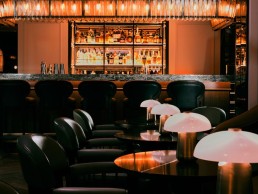
Mayfair Townhouse, UK
The Mayfair Townhouse luxury hotel receives a design overhaul from Goddard Littlefair and Kate & Sam Lighting Designs, inspired by the flamboyant Oscar Wilde and his contemporaries.
Opening at the end of last year, the latest design instalment from Goddard Littlefair is The Mayfair Townhouse, the fifth luxury hotel from London and Regional’s collection of Iconic Luxury Hotels and is located in the heart of Mayfair on Half Moon Street, near London’s Green Park.
The boutique hotel comprises seven Georgian listed buildings within its structure of 15 townhouses, providing a unique hospitality experience for guests seeking a discreet London destination.
Notably, the townhouses lining Half Moon Street were once home to British historic figure Oscar Wilde and provided the setting of arguably his most famous play The Importance of Being Ernest. Known for his flamboyant influences, Wilde and his contemporaries spearheaded the Aesthetic Movement in England that celebrated beauty and design in reaction to the dominant, industrial revolution.
This rich history provided the foundations from which Goddard Littlefair drew direct inspiration from in order to create the indulgent design for The Townhouse. “They also led a rich and indulgent lifestyle, being provocative in order to court controversy. The design we pursued for the Townhouse marries Old and New Mayfair, with a layer of 1920s extravagance,” explains Jo Littlefair, Co-Founder and Director of Goddard Littlefair.
“There are almost no identical rooms in the entire building,” adds Martin Goddard, Co-Founder and Director of Goddard Littlefair. “Added to that, previous incarnations of hotels had wiped away period details leaving us with few historic references for the interiors. We had to set up a design language that could relate to the architecture and be interpreted into each room through panelling, colouration and distinctive detailing. The result is a unity through the bedrooms but guests who stay multiple times will have a different experience on each occasion.”
Capturing this playful spirit, Goddard Littlefair delved into the personalities of the original inhabitants of the area. The flamboyant dressing, pursuit of beauty and eccentric quality of the time is successfully interwoven in the design and has transpired through the fabrics, colours, intricate detailing and subtle layers throughout the hotel. Hints of extrovert personalities that lie beneath the building have been captured by Goddard Littlefair’s choice of colour palette and flashes of details, subtly capturing the adventurous mischief of the dandy.
“As the project evolved and understanding for the building and the aesthetic developed, the brief naturally shape-shifted to fit more uniquely with the bones of the buildings,” adds Littlefair.
“The main challenges of this project were working within the constraints of the existing building, which is made up of 15 Georgian Townhouses. There is no one space alike, and each with its own character. The public spaces are small and intimate, the ceilings are low, so we carefully designed the spaces creating a sense of space with the clever use of mirror and light. Although there were challenges with the spaces, they all add to the charm and character of the hotel, and these smaller spaces have helped us create a truly intimate and embracing experience.”
Upon entering the hotel, guests are greeted at the discreet reception desk, with warm glowing bespoke alabaster lamps and cut-crystal Contardi lanterns casting shadows on the ceiling, while a piece from Art et Floritude adorns the lift lobby.
“One of the challenges of the ground floor was the limited ceiling height not allowing for grand gestures overhead. Instead, we aspired to create a layered approach that would draw your eye down and into the space,” describes Littlefair.
Adjacent to the reception area is the aptly named Dandy Bar. Located in the heart of the hotel on the ground floor, Goddard Littlefair’s design lures you in with a twinkling, dimly lit atmosphere pulling you away from the busy streets of Mayfair.
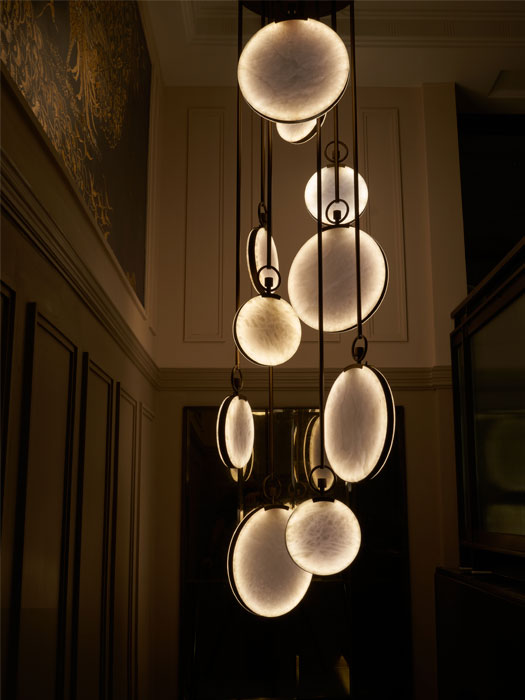
“Cantilevered shades spread their arms over the central seating area of the bar, while raffia wall lights [from Colonel Shop] mounted on lacquered wall panels hint at travels further afield and the glamour of a trip to far-flung places. The showcase in this area is the feature gantry [bespoke from Northern Lights] above the bar made from hand-cut feathers and the feature alabaster disc chandelier [from Contardi], which cascades over the staircase. Both of these provide drama and intrigue and draw you into the space to explore further,” details Littlefair.
“We looked at the flamboyance of feathers in flapper outfits and the traditional gentleman’s pocket watch to inspire the design of both of these pieces,” adds senior designer Gemma Prentice.
Moving below to the lower ground floor, guests will find the Club Room, which acts as a library space, a snug room nicknamed The Den and the restaurant.
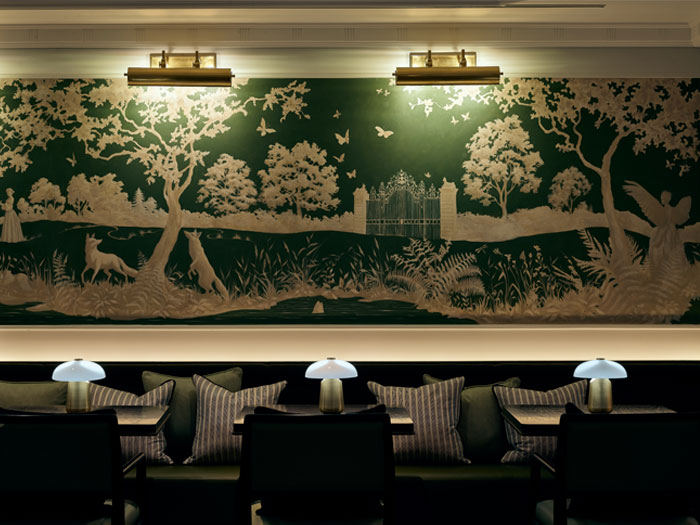
“Having no natural daylight in the lower ground floor, we strove to ensure that light levels were good without being overbearing or obvious,” elaborates Littlefair. “A series of panels on the back wall mimic windows to give the illusion of daylight, these all provide a glow of light to the back wall. A set of six built in shelving units on the other two walls, which are used to display objet d’art but which also form a part of the lighting scheme, highlighting a bashful raspberry colour in the recess that provides a highlight to the overall scheme. Again, challenges to ceiling heights entailed clever design of decorative lighting, notably cantilevered wall lights that project out into the space providing a general glow while directing light onto tables.
“The same wall light was used within the small private snug area of the restaurant placed into the four corners of the room, helping create a cosy, intimate space. Flush alabaster ceiling lights were used here to allow for flexibility in seating arrangements and bespoke alabaster ceiling lights were used down the corridor, which leads you down towards the function room, WCs and gym,” she adds.
“Picture lights are used to highlight all the artwork, which is more sympathetic to the original Georgian Townhouse spirit.”
The lighting pieces referenced by Littlefair in this area of the hotel include bespoke cantilevered wall lights and corridor lights from Contardi, ceiling lights and picture lights from Visual Comfort and the private dining pendant from Moooi.
In addition to these spaces, also occupying the lower ground level is a multi-use function room. “As a multifunctional space, lower ground area, we wanted to ensure that there was still an emphasis on the decorative lighting but that it would also not overpower the space. A series of wall lights [with bespoke adaptations of standard fabric shades from Servomuto] run around the perimeter on panels, which mimic windows, while a feature circular pendant [bespoke from Contardi] with tiered fringe panels in an ombre effect provides a dramatic centre piece,” continues Littlefair. “Artwork throughout the hotel has been carefully curated and here [Visual Comfort] picture lights highlight the hand-painted mural depicting scenes of Green Park, which is within striking distance of the hotel.”
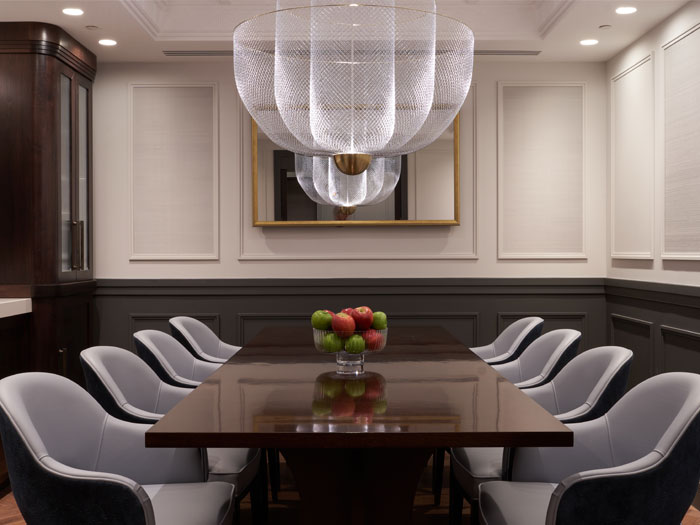
Moving to the guest rooms above, nearly each room is unique from the other. The Garden suites gave Goddard Littlefair the opportunity to work with an indoor/outdoor scheme that took inspiration from British Fashion Photographer Cecil Beaton and his love of gardens. “The position of these suites on the ground floor of the property meant we could incorporate some of the exterior of the building into the rooms. Inspired by Cecil Beaton’s love of gardens, we created a crittal framed conservatory with doors opening to a small, walled courtyard allowing the guest their own English garden in the heart of London,” says Littlefair.
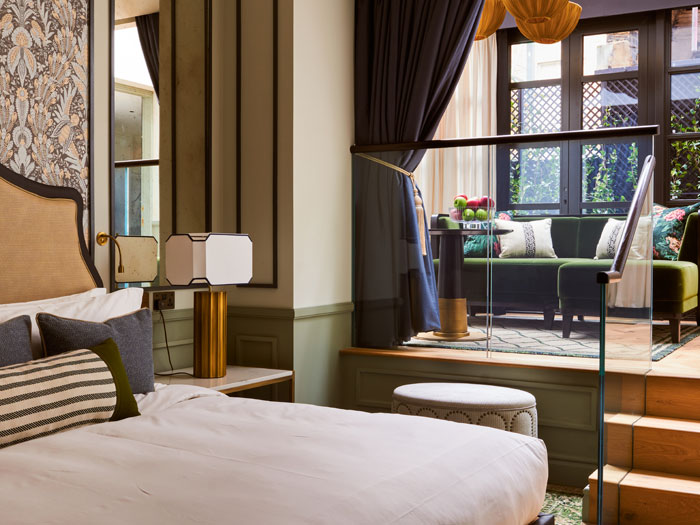
Two additional suites on the fifth floor of the hotel had working titles of the Penthouse Suites during the design process. The design intent for these two spaces drew inspiration from the fictitious but contemporary Dandy muse. “What decadence would this person embrace and how would they wish to live in the 21st century Mayfair, were questions we posed to ourselves during the evolution of these designs,” says Goddard.
Littlefair adds: “We used a subtle yet rich colour scheme and wanted the lighting to bring another layer of materiality. Faux alabaster and antique brass fashioned in contemporary shapes that nodded to the past bring warmth to the rooms.” Northern Lights provided bespoke bedside lights in the Executive suites and bespoke fixtures from Contardi in the Deluxe Rooms included bedside lights, flood lamps and picture lights, and pendants from A Shade Above were featured in the garden rooms.
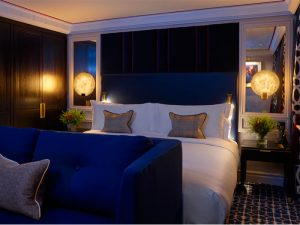
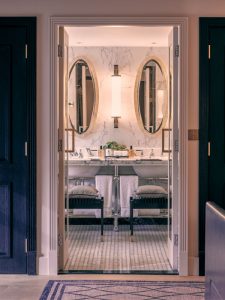
When working and designing this quirky space, it was important for the team to ensure an aesthetically pleasing balance of light throughout. Littlefair continues: “We wanted the architectural lighting to be minimal and for the decorative lighting to be the focus in this project. The architectural lights are well concealed and all integrated into the design elements so that they don’t create a focus but work together with the decorative lighting to create intimate spaces.” This led the team to work with Kate & Sam Lighting Designs to approach the architectural lighting design. “We feel having a lighting designer on a project is key,” explains Littlefair. “Lighting plays such an important role within interior design, and if the lighting output isn’t right then it can make or break a project. Kate & Sam helped to establish the architectural lighting design while being sympathetic to our decorative lighting. They ensured that we used fittings that would not dominate our design but sit discreetly within. All of the fittings were set onto dimming systems and scene settings were programmed to ensure that the lighting levels were optimised throughout the day. This is all crucial for creating the right environment and intimate feel for the hotel. We normally work with a lighting designer on all of our hospitality projects.”
Kate Wilkins, of Kate and Sam Lighting Designs, adds: “Decorative lighting is always crucial for the aesthetic, the placement essential for the layering, and the lamps for dimming complementing and setting the moods”.
Working with the light settings and programmes, the duo ensured the lighting scenarios guaranteed a welcoming atmosphere for guests on arrival, focusing the eye where needed, and complementing the times of day and task lighting to flatter and provide an all-round feel-good energy for guests. “The basement was the trickiest area, as there is no natural light and needs to provide breakfast with a townhouse club feel,” explains Wilkins. “So, we introduced some different colour temperatures suggesting daylight in wall details. And, in the evenings, complementing the exclusive club mood. Scene setting was crucial to the spaces.”
Reflecting on the project after completion, both Goddard Littlefair and Kate & Sam were very pleased with the outcome.
“The lighting truly helps to create and emphasise that residential and intimate feel that we wanted. It creates a sense of warmth and invites you into the space. Standing on the street at the entrance of the hotel, it’s the lighting that catches your eye and draws you in, especially the feature lit gantry above the bar. The lighting works seamlessly with the design as a whole, it’s delicate balance of traditional and contemporary.
“We wanted each space to have its own design language and therefore each space has its own decorative lighting design. To emphasise the residential feel, there are multiple designs of lighting that also create a lovely, layered feel. It was about a richness of material to convey luxury and indulgence, using brass, alabaster, pleated silk and hand-crafted glass,” she adds.
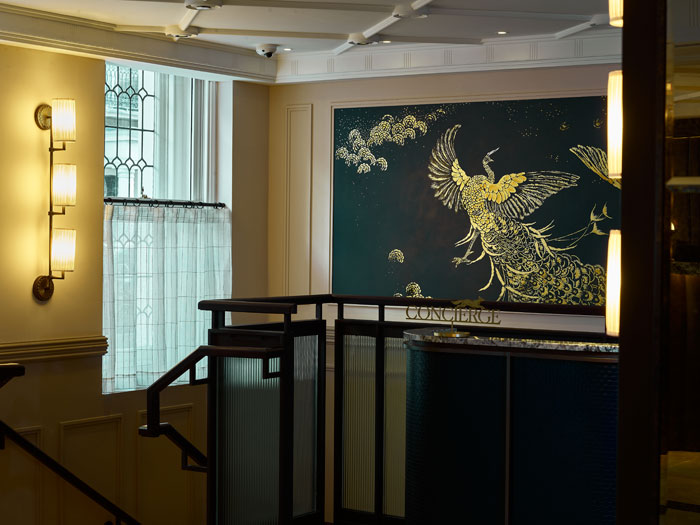
“Almost all the lighting was bespoke, and we particularly enjoyed the process of creating the gantry bar light, which utilised a bespoke mould to create each glass element that were then finished by hand with an antique gold paint finish. Reaching the final finish and quality of the glass required really utilised all the knowledge and skills of the artisans involved.
“We were very pleased with how the design turned out. We were able to realise the majority of all of our initial plans and ideas.” concludes Littlefair.
Wilkins adds: “This was the first time [working with Goddard Littlefair], and we really enjoyed it. They were open to ideas, suggestions and comments. Hope they feel the same way! When things open up, we can’t wait to sit in front of the glowing bar and enjoy some cocktails.”



